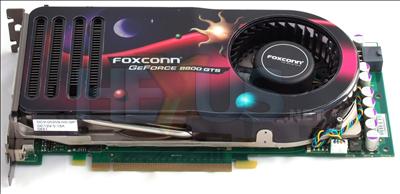Card appearance and thoughts
It looks like a regular GeForce 8800 GTS, doesn't it? The only meaningful difference between the 320MiB and 640MiB versions is in the use of memory chips - still 10 in both cases - that are half the density in the 320MiB's case. Everything else, it seems, is left untouched in the transition between SKUs. If you want to know what makes the 8800-series tick head over to our comprehensive review.
The cooler is identical to a 640MiB GTS' but slightly different to the one that's specified on all reference 8800 GTX models. The HSFs are noted for quietness of operation, both in 2D and under 3D load, so Foxconn naturally benefits from NVIDIA's base design.
The design may be reference but, crucially, the clock speeds aren't. Default-clocked GeForce 8800 GTS' run at 500/1200/1600 for the core, shader and memory speeds, respectively. Foxconn is shipping its 320MiB version with an overclocked 575MHz core speed, shaders at the default 1200MHz, and memory at 1800MHz. Achieving a 575MHz core speed should be within the compass for the vast majority of G80 cores, we reckon. Foxconn is using Hynix 1.1ns GDDR3 256MBit memory chips as opposed to a 640MiB's Samsung 1.2ns GDDR3 512MBit. That's how the effective 1800MHz DRAM speed has been reached.
You may be thinking, then, that the Foxconn GeForce 8800 GTS 320MiB OC card is close to regular GTX speeds. Think again, because the GTX is further differentiated by having 128 stream processors compared to the GTS' 96, and whilst the memory speed is similar, GTX cards carry 12 512MBit (768MiB) modules that interface with the GPU via a 384-bit bus; GTS' operate via a reduced 320-bit interface. The extra dollops of performance give the GTX a clear edge in our benchmarks, as you will see.
The 8800 GTS SKU's PCB is shorter than the GTX's, measuring in at around 240mm. It also only requires a single PEG connector for auxillary power, as well.
Dual-link DVI is always worth a mention.
Summary
The FV-N88SMCD2-ONOC is the first pre-overclocked graphics card we've seen from Foxconn. It has half the framebuffer of the previously released GeForce 8800 GTS, but with both core and memory speeds bumped up, performance should be solid. The interesting aspect will be to see just how the half-sized framebuffer affects performance as we dial up the resolution and image quality.G80 comparison
Making a little sense of the various clocks speeds, mentioned above, and how they relate to the rest of the family, here's a brief table with some performance-defining parameters that put the Foxconn's vital statistics into some kind of context.| Card | Foxconn GeForce 8800 GTS OC 320MiB | XFX GeForce 8800 GTS XXX 320MiB | ASUS GeForce 8800 GTS 640MiB | Foxconn GeForce 8800 GTX 768MiB |
|---|---|---|---|---|
| Core clock | 575MHz | 580MHz | 513MHz | 575MHz |
| Stream processors | 96 (6x16) | 96 (6x16) | 96 (6x16) | 128 (8x16) |
| Shader clock | 1200MHz | 1500MHz | 1200MHz | 1350Mhz |
| Framebuffer | 320MiB | 320MiB | 640MiB | 768MiB |
| Memory clock | 1800MHz | 1800MHz | 1600MHz | 1800MHz |
| Memory bus width | 320-bit | 320-bit | 320-bit | 384-bit |
| Memory bandwidth | 72GB/s | 72GB/s | 64GB/s | 86.4GB/s |
The table should illustrate why the overclocked Foxconn GeForce 8800 GTS 320MiB won't be a match for a regular-clocked GeForce 8800 GTX. It has fewer general-purpose processors, a narrower memory bus, and, of course, a far smaller framebuffer.
Framebuffer considerations aside, it will be faster than a regular GeForce 8800 GTS 640MiB card. [advert]














